
Clearance cairn
Encyclopedia
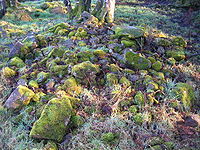
Fieldstone
Fieldstone is a building construction material. Strictly speaking, it is stone collected from the surface of fields where it occurs naturally...
s which have been removed from arable land or pasture to allow for more effective agriculture
Agriculture
Agriculture is the cultivation of animals, plants, fungi and other life forms for food, fiber, and other products used to sustain life. Agriculture was the key implement in the rise of sedentary human civilization, whereby farming of domesticated species created food surpluses that nurtured the...
and collected into a usually low mound or cairn
Cairn
Cairn is a term used mainly in the English-speaking world for a man-made pile of stones. It comes from the or . Cairns are found all over the world in uplands, on moorland, on mountaintops, near waterways and on sea cliffs, and also in barren desert and tundra areas...
. Commonly of Bronze Age
Bronze Age
The Bronze Age is a period characterized by the use of copper and its alloy bronze as the chief hard materials in the manufacture of some implements and weapons. Chronologically, it stands between the Stone Age and Iron Age...
origins, these cairns may be part of a cairnfield (a collection of closely spaced cairns) where some cairns might be funerary. Clearance cairns are a worldwide phenomenon wherever organised agriculture has been practised.
Purpose of clearance
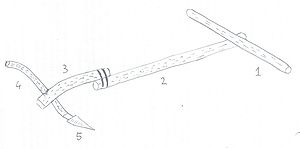
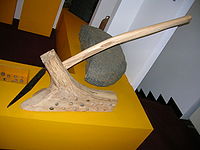
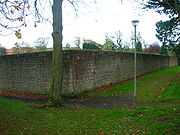
Heat radiation
The possibility exists that the stone piles were built in the middle of the enclosures, with an additional purpose of maximising the effects of daytime radiance; the holding in of heat caught during the day, and its release at night would increase the temperature of the field very slightly. This effect would encourage crop growth and reduce the risk of frost. Walled gardens produce the same effect.Creation of clearance cairns
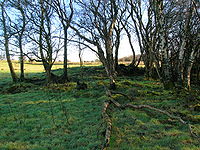

The amount of stone which needed to be cleared from fields depended upon the local geology, glacial deposits, glacial erratics, etc. Many cairns are mainly composed of stones which could have been carried by a single person who would have followed the plough as it turned up small boulders, etc.
Some surviving cairns are of considerable antiquity as field clearance has been practised since the beginnings of agriculture in the Stone Age, such as at the Gardberg site
Gardberg site
The Gardberg site is an archaeological site in Vestre Slidre, Oppland, Norway. The site consists of several burial cairns and clearance cairns as well as areas of early industry and farming. Investigations have established that the site was in use from the Stone Age to modern times. The Einang...
in Vestre Slidre
Vestre Slidre
Vestre Slidre is a municipality in Oppland county, Norway. It is part of the traditional region of Valdres. The administrative centre of the municipality is the village of Slidre...
, Oppland
Oppland
is a county in Norway, bordering Sør-Trøndelag, Møre og Romsdal, Sogn og Fjordane, Buskerud, Akershus, Oslo and Hedmark. The county administration is in Lillehammer. Oppland is, together with Hedmark, one of the only two landlocked counties of Norway....
, Norway
Norway
Norway , officially the Kingdom of Norway, is a Nordic unitary constitutional monarchy whose territory comprises the western portion of the Scandinavian Peninsula, Jan Mayen, and the Arctic archipelago of Svalbard and Bouvet Island. Norway has a total area of and a population of about 4.9 million...
. A Bronze Age
Bronze Age
The Bronze Age is a period characterized by the use of copper and its alloy bronze as the chief hard materials in the manufacture of some implements and weapons. Chronologically, it stands between the Stone Age and Iron Age...
origin for clearance cairns is more common.
Characteristics



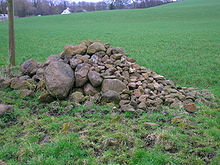
Other items such as bog-wood
Bog-wood
Bog-wood, also known as morta is wood from trees that have been buried in peat bogs and preserved from decay by the acidic and anaerobic bog conditions, sometimes for hundreds or even thousands of years. The wood is usually stained brown by tannins dissolved in the acidic water...
and grubbed out tree stumps were sometimes added to the cairns as a result of tree felling and the process of creation of pasture from woodland. Bog-wood stumps and trunks can be thousands of years old, are darker in colour due to the tannin
Tannin
A tannin is an astringent, bitter plant polyphenolic compound that binds to and precipitates proteins and various other organic compounds including amino acids and alkaloids.The term tannin refers to the use of...
s from the peat and do not show typical wood decomposition characteristics due to their preservation within peat bogs. The absence of saw marks indicates felling using axes, providing further information about the age of the wood involved.
Some clearance cairns are linear in form. Many of the smaller cairns were probably created by family groups, whilst larger ones would have required organised labour.
Cairnfields have on occasions been confused with various other classes of monuments, such as round barrow cemeteries and groups of round barrows stone hut circles, ring cairns, or burnt mounds. In general round barrows are larger, more regular, and may contain visible traces of a cist or kerb; stone hut circles have distinct entrances; ring cairns have a hollow centre; and burnt mounds contain a high proportion of fire-crazed stones of rather smaller size than appear in the average clearance cairns within cairnfields.
Natural deposits such as so called 'clitter agglomerates', morains can also on occasion look rather similar to groups of clearance cairns, but their context, position and regular form usually betrays their true origins.
Clearance cairn material is often heterogeneous, typically consisting of both edged and rounded small stones, sometimes mixed with sand, clay or silt, lifted from the field nearby. Agricultural and clearance cairns are sometimes located on slopes, whilst burial cairns rarely are.
Clearance cairns constructed using mechanised methods with horse or motor powered assistance may appear superficially similar, however the stones are generally much larger and they are more randomly tipped rather than hand placed.
Natural history
Due to the age and 'abandoned' state of many clearance cairns they are often good sites for the growth and survival of lichens, mosses, ferns and other plants; the actual species being dependent on the rock type. Cairns are relatively undisturbed and emulate old walls for the micro-habitats they produce.Landscape history
In some areas which are now unproductive moorland, aerial photographs show the presence of numerous prehistoric clearance cairns and associated dwellings such as hut-circles. This clear evidence of previous ancient habitation and cultivation shows that the climate worsened until the farmers were forced to move to lower ground.Stone carrying
Stone carryLifting stone
Lifting stones are common throughout northern Europe, particularly Scotland, Iceland , Scandinavia and Northern England. They were usually heavy local stones, without any modification, with the challenge being to lift such a stone, proving your strength...
or the stone walk is a traditional Scottish athletic event involving the carrying of large stones down the field of competition; the competitors pick up two heavy stones with iron handles, and carry the pair as far as they can.

